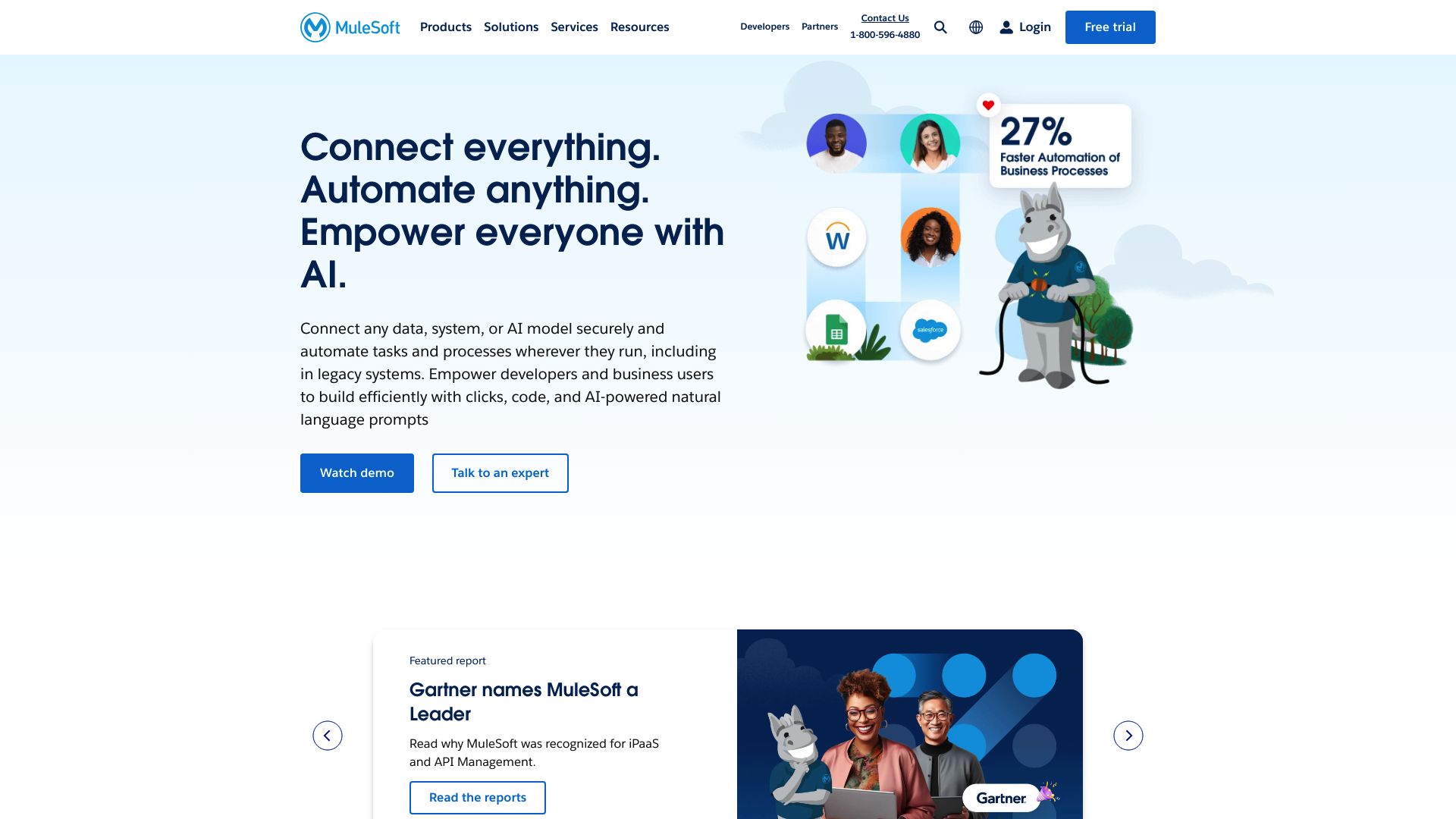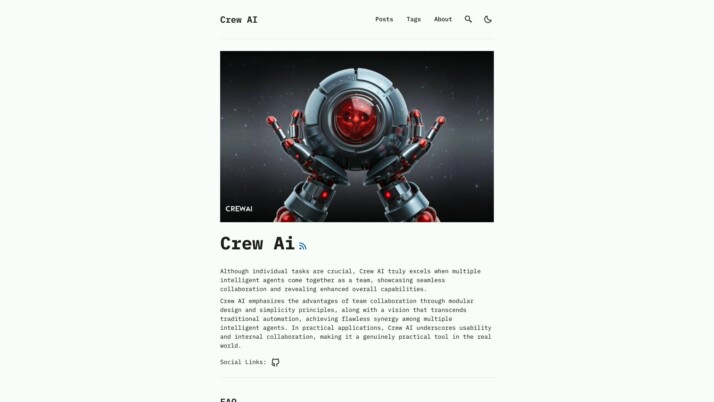MuleSoft vs. CrewAI: Enterprise Integration or AI Collaboration?
AI platforms are transforming how businesses operate, innovate, and solve complex problems. This comparison explores MuleSoft’s enterprise integration capabilities, CrewAI’s collaborative agent framework, and SmythOS’s revolutionary approach to AI development. We’ll examine how each platform tackles API management, agent orchestration, and AI integration, highlighting their strengths and limitations.
Whether you’re a developer seeking powerful tools, a business leader exploring AI solutions, or an innovator pushing the boundaries of multi-agent systems, this analysis will guide you through the features, use cases, and potential impact of these cutting-edge platforms. Discover which solution best aligns with your organization’s needs and learn how SmythOS is redefining the landscape of AI automation and integration.
Mulesoft Overview
Mulesoft delivers a comprehensive integration platform designed to connect applications, data, and devices across on-premises and cloud environments. The Anypoint Platform empowers organizations to design, build, and manage APIs and integrations, enabling seamless digital transformation and enhanced operational efficiency.


Mulesoft’s flagship product, the Anypoint Platform, offers a full-lifecycle API management solution. It includes Anypoint Studio for visual development, CloudHub for cloud deployment, and Anypoint Flex Gateway for API security and governance. These tools cater to developers, IT managers, and business users seeking to streamline integration processes and leverage AI capabilities.
Mulesoft’s flagship product, the Anypoint Platform, offers a full-lifecycle API management solution… cater[ing] to developers, IT managers, and business users seeking to streamline integration processes.
Key features of Mulesoft include API-led connectivity, AI-powered integrations, and robust security measures. The platform supports various environments, including development and production, and provides both visual builders and no-code options. Mulesoft integrates with AI models like OpenAI and custom solutions, enhancing problem-solving capabilities across industries.
While Mulesoft offers powerful integration tools, users may face challenges in terms of complexity and learning curve, especially for those new to API management. The platform’s enterprise focus may also make it less suitable for small-scale projects or individual developers with limited resources. Additionally, pricing can be a consideration for smaller organizations or those with budget constraints.
Mulesoft’s integration capabilities extend to various systems and platforms, including data lakes, AI services, and third-party APIs. The platform supports deploying solutions as APIs, webhooks, and scheduled agents, offering flexibility in implementation. Mulesoft’s scalability and security features, including data encryption and OAuth support, make it suitable for large-scale enterprise deployments.
CrewAI Overview
CrewAI empowers developers to orchestrate collaborative AI agent teams for complex task solving. This open-source framework enables the creation of specialized agents with defined roles, goals, and skills to work together in structured workflows.


CrewAI’s Python library allows developers to configure AI agents, assign specific tasks, and manage their collaboration through customizable processes. The framework handles much of the complexity of agent coordination, freeing developers to focus on defining agents and workflows tailored to their needs.
CrewAI empowers developers to orchestrate collaborative AI agent teams for complex task solving. This open-source framework enables the creation of specialized agents with defined roles, goals, and skills to work together in structured workflows.
Key features of CrewAI include role-based agent design, flexible task delegation, and human-in-the-loop integration. Agents can autonomously hand off or collaborate on tasks, utilizing tools to incorporate human input when needed. The process-driven approach ensures coordinated teamwork between agents.
While CrewAI offers powerful capabilities for multi-agent AI systems, it requires Python programming knowledge, which may limit accessibility for non-technical users. The open-source nature of the platform allows for community contributions, but this can also lead to potential inconsistencies in documentation and support.
CrewAI’s modular architecture fosters creative applications across various industries. However, users should consider the learning curve associated with implementing and managing complex agent interactions. As an evolving platform, CrewAI continues to expand its features and capabilities, driven by community input and emerging AI technologies.
Feature Comparison
MuleSoft and CrewAI offer distinct approaches to AI agent development and integration. MuleSoft provides a comprehensive enterprise integration platform with robust API management capabilities, while CrewAI focuses on orchestrating collaborative AI agent teams for complex problem-solving.
MuleSoft excels in enterprise-grade features like full lifecycle API management, extensive security measures, and scalable deployment options. Its Anypoint Platform supports visual development through Anypoint Studio and no-code options via Flow Builder. MuleSoft integrates with various AI models and services, enabling AI-powered workflows across an organization’s technology stack.
CrewAI, as an open-source framework, emphasizes flexibility in creating specialized AI agents with defined roles and goals. It allows for autonomous task delegation and collaboration between agents, making it well-suited for developers building sophisticated multi-agent systems. CrewAI’s strength lies in its process-driven approach to coordinating teamwork between AI agents.
Both platforms support integrating with foundation AI models and APIs, but MuleSoft’s enterprise focus results in more comprehensive security features, including data encryption, OAuth support, and IP control. CrewAI, while powerful for collaborative AI development, may require more hands-on configuration for enterprise-level security and scalability.
Feature Comparison Table
| Mulesoft | CrewAI | SmythOS | |
|---|---|---|---|
| CORE FEATURES | |||
| Hosted Agents (Dev, Production) | ✅ | ❌ | ✅ |
| Environments (Dev, Production) | ✅ | ❌ | ✅ |
| Visual Builder | ✅ | ❌ | ✅ |
| No-Code Options | ✅ | ❌ | ✅ |
| Memory & Context | ❌ | ✅ | ✅ |
| Explainability & Transparency | ❌ | ❌ | ✅ |
| Debug Tools | ✅ | ❌ | ✅ |
| Multimodal | ✅ | ❌ | ✅ |
| Problem-Solving Capabilities | ❌ | ✅ | ✅ |
| Human-AI Interaction | ❌ | ✅ | ✅ |
| Audit Logs for Analytics | ❌ | ❌ | ✅ |
| SECURITY | |||
| Constrained Alignment | ✅ | ❌ | ✅ |
| Data Encryption | ❌ | ❌ | ✅ |
| OAuth | ✅ | ❌ | ✅ |
| IP Control | ✅ | ❌ | ✅ |
| COMPONENTS | |||
| Foundation AIs | ✅ | ❌ | ✅ |
| Huggingface AIs | ❌ | ❌ | ✅ |
| Zapier APIs | ❌ | ❌ | ✅ |
| All other APIs, RPA | ❌ | ❌ | ✅ |
| Classifiers | ✅ | ❌ | ✅ |
| Logic | ❌ | ❌ | ✅ |
| Data Lakes | ✅ | ❌ | ✅ |
| DEPLOYMENT OPTIONS (EMBODIMENTS) | |||
| Deploy as API | ✅ | ❌ | ✅ |
| Deploy as Webhook | ✅ | ❌ | ✅ |
| Staging Domains | ✅ | ❌ | ✅ |
| Production Domains | ✅ | ❌ | ✅ |
| API Authentication (OAuth + Key) | ✅ | ❌ | ✅ |
| Deploy as Site Chat | ✅ | ❌ | ✅ |
| Deploy as Scheduled Agent | ❌ | ❌ | ✅ |
| Deploy as GPT | ✅ | ❌ | ✅ |
| Scalability | ❌ | ✅ | ✅ |
| DATA LAKE SUPPORT | |||
| Hosted Vector Database | ✅ | ❌ | ✅ |
| Sitemap Crawler | ❌ | ❌ | ✅ |
| YouTube Transcript Crawler | ❌ | ❌ | ✅ |
| URL Crawler | ❌ | ❌ | ✅ |
| PDF Support | ❌ | ❌ | ✅ |
| Word File Support | ✅ | ❌ | ✅ |
| TXT File Support | ✅ | ❌ | ✅ |
Best Alternative to Mulesoft and CrewAI
SmythOS stands out as the superior alternative to Mulesoft and CrewAI for AI agent development and deployment. Our platform combines the best of both worlds, offering enterprise-grade features with the flexibility and collaborative capabilities that modern AI development demands.
We provide a comprehensive solution that addresses the limitations of both Mulesoft and CrewAI. Unlike Mulesoft’s complex enterprise integration focus or CrewAI’s narrow emphasis on collaborative AI teams, SmythOS delivers a versatile, user-friendly platform for creating and managing AI agents across various use cases.
SmythOS delivers a versatile, user-friendly platform for creating and managing AI agents across various use cases.
Our visual builder and no-code options democratize AI development, making it accessible to both technical and non-technical users. This approach significantly reduces the time and resources needed to create sophisticated AI solutions, allowing businesses to innovate faster and more efficiently than with Mulesoft or CrewAI.
SmythOS excels in areas where Mulesoft and CrewAI fall short. We offer robust memory and context management, ensuring AI agents maintain coherent, context-aware interactions. Our platform provides unparalleled explainability and transparency, critical for building trust in AI systems. Additionally, we support multimodal interactions and provide advanced problem-solving capabilities, enabling AI agents to tackle complex tasks across various domains.
Unlike CrewAI’s limited deployment options or Mulesoft’s complex setup requirements, SmythOS offers versatile deployment choices. We enable users to easily deploy AI agents as APIs, webhooks, scheduled tasks, or integrate them into existing systems. This flexibility, combined with our scalable architecture, ensures that SmythOS can meet the evolving needs of businesses of all sizes, from startups to large enterprises.
Conclusion
Mulesoft and CrewAI offer powerful solutions for enterprise integration and AI agent orchestration, respectively. Mulesoft’s Anypoint Platform excels in API management and enterprise-grade security, while CrewAI provides a flexible framework for collaborative AI agent teams. However, SmythOS emerges as the superior choice, combining the strengths of both platforms and addressing their limitations.
SmythOS revolutionizes AI agent development with its intuitive drag-and-drop interface, extensive integration ecosystem, and versatile deployment options. Unlike Mulesoft’s complex enterprise focus or CrewAI’s code-heavy approach, SmythOS democratizes AI development, making it accessible to technical and non-technical users alike. Our platform’s support for multimodal interactions, problem-solving capabilities, and seamless integration with various AI models and APIs sets it apart from competitors.
With SmythOS, users can create sophisticated multi-agent systems, deploy them across multiple platforms, and leverage advanced features like constrained alignment and data encryption. Our platform’s scalability, coupled with features like the Agent Work Scheduler and comprehensive logging, ensures that businesses of all sizes can harness the power of AI efficiently and securely.
Experience the future of AI automation with SmythOS. Create a free account today and discover how our platform can transform your workflows, boost productivity, and drive innovation across your organization. With our 30-day money-back guarantee and unlimited agent creation, there’s no risk in exploring the endless possibilities SmythOS offers. Unleash the power of AI for your business and stay ahead in the rapidly evolving digital landscape.
Last updated:
Disclaimer: The information presented in this article is for general informational purposes only and is provided as is. While we strive to keep the content up-to-date and accurate, we make no representations or warranties of any kind, express or implied, about the completeness, accuracy, reliability, suitability, or availability of the information contained in this article.
Any reliance you place on such information is strictly at your own risk. We reserve the right to make additions, deletions, or modifications to the contents of this article at any time without prior notice.
In no event will we be liable for any loss or damage including without limitation, indirect or consequential loss or damage, or any loss or damage whatsoever arising from loss of data, profits, or any other loss not specified herein arising out of, or in connection with, the use of this article.
Despite our best efforts, this article may contain oversights, errors, or omissions. If you notice any inaccuracies or have concerns about the content, please report them through our content feedback form. Your input helps us maintain the quality and reliability of our information.
